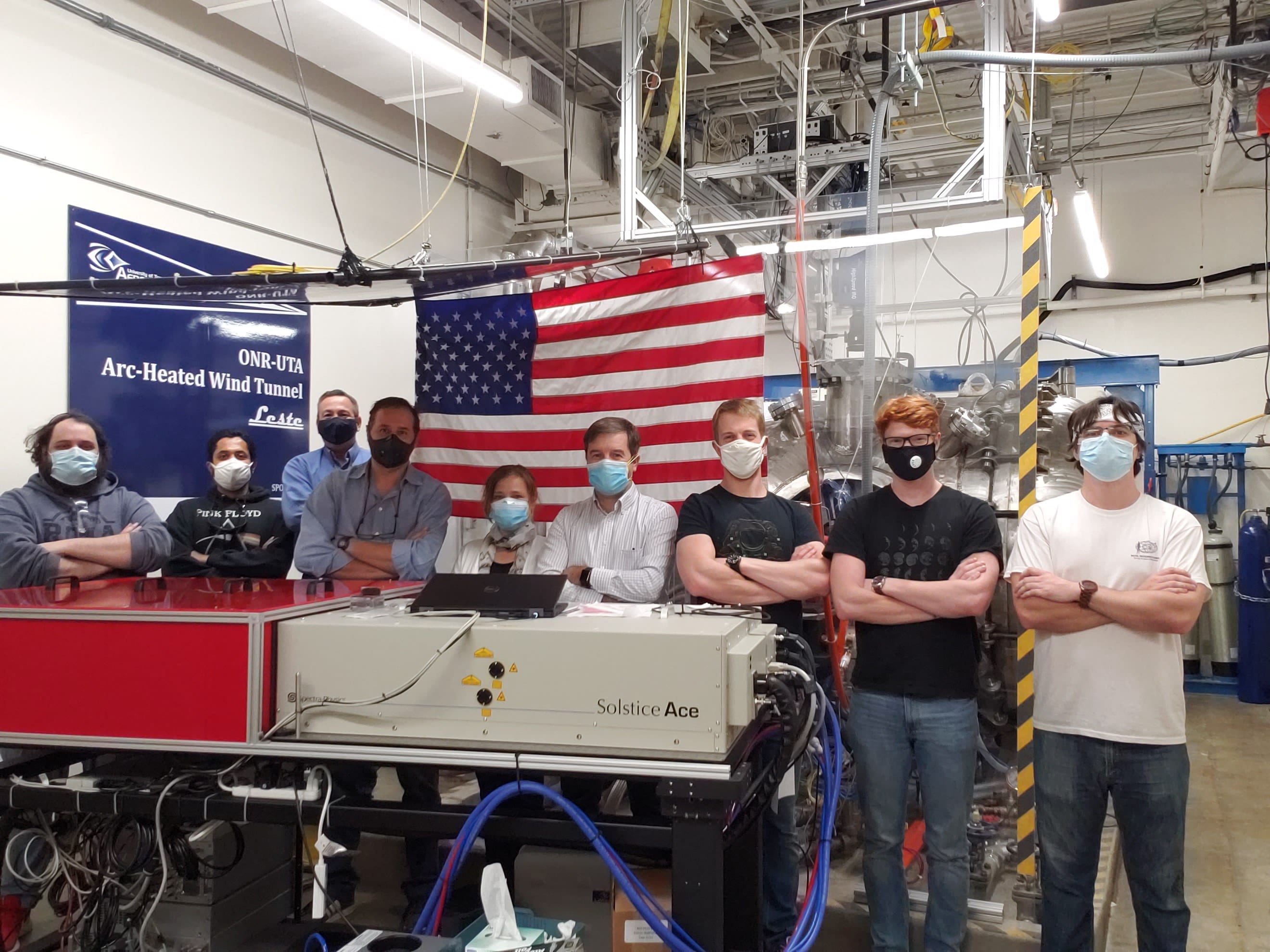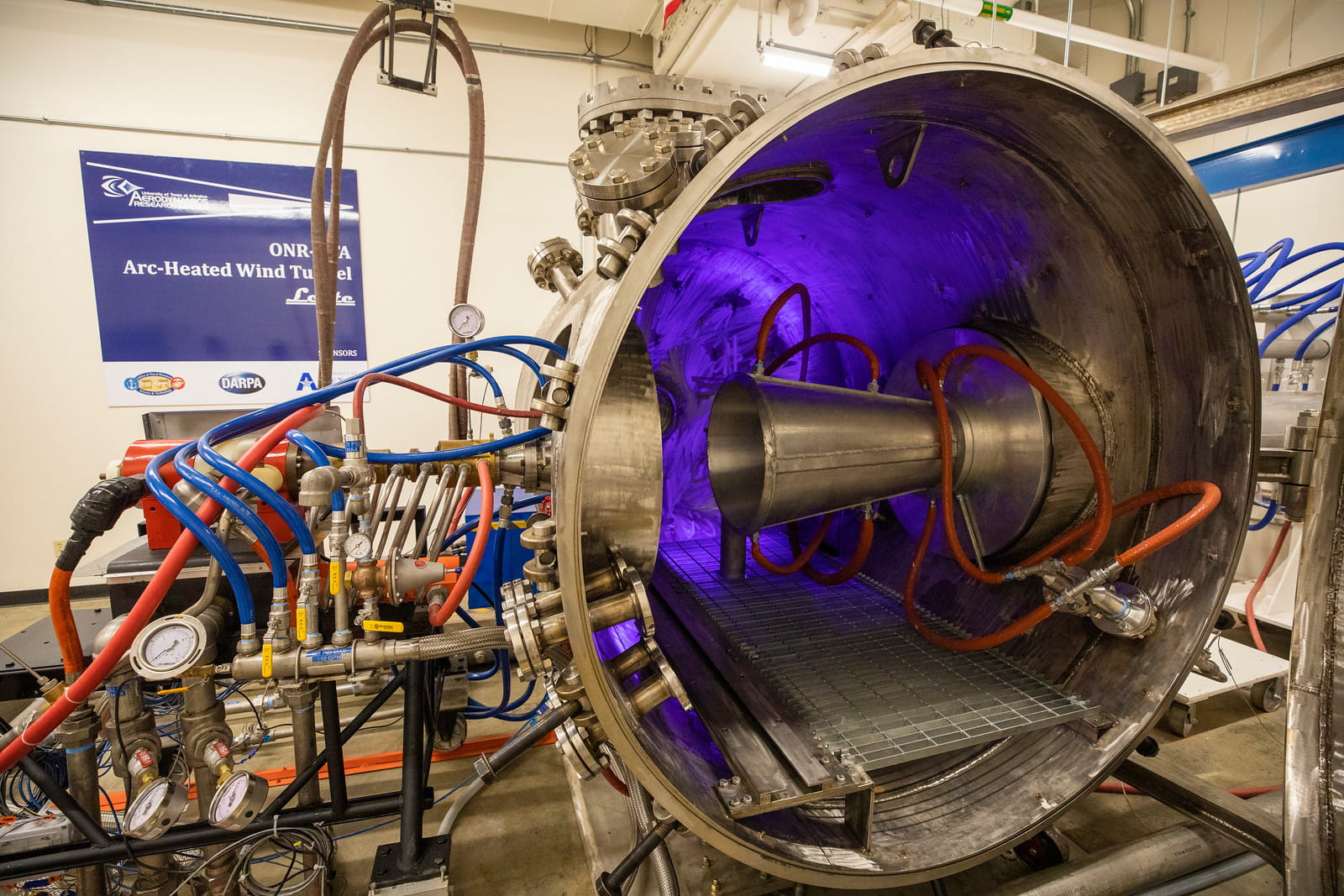Milestone measurements in arc-jet plasma wind tunnel

A team from the Aerodynamic Research Center (ARC) at The University of Texas at Arlington has pioneered two cutting-edge measurement techniques in its state-of-the-art arc-jet plasma wind tunnel.
The research team accomplished two milestones: measuring the composition of atomic species and measuring flow velocity in the high enthalpy environment generated in the ARC’s arc-jet plasma wind tunnel. Enthalpy is a measure of the energy contained in the hypersonic flow.
Information on composition and velocity in arc-jet flows is critical to understanding the testing conditions generated by the plasma wind tunnel. It provides invaluable data for better numerical simulations, transitions, heat shields testing and the fundamental understanding of hypersonic aerothermodynamics, said Luca Maddalena, UT Arlington professor of aerospace engineering and ARC director.
“The arc-jet environment is an extremely challenging one for optical diagnostics,” said Maddalena. “This development is spectacular in overcoming those challenges and also in leading the way for others to follow.”
UTA’s arc-heated, hypersonic wind tunnel—the only one of its kind in the nation at a university—came online in 2019. Through funding from the Office of Naval Research (ONR), research at the wind tunnel focuses on developing advanced laser-based measurements of plasma flow for the study of heat shields for hypersonic vehicles.
When hypersonic vehicles cruise through the atmosphere at 3,500 miles per hour or faster, friction causes them to heat up to more than 8,000 degrees Kelvin, or about 15,000 degrees Fahrenheit. At these temperatures, superheated plasma flows around the vehicle and evolves as it does so, making it necessary for engineers to calculate simultaneously its chemistry and fluid dynamics to develop an effective heat shield.
Current models are not able to accurately predict what will happen in every situation, so Maddalena and his team have been developing diagnostic techniques to characterize the plasma flow, thereby improving the understanding of the relationship between test environments and flight environments.
The state-of-the-art technique utilized to carry out atomic species composition measurements is known as femto-second two-photon absorption laser induced fluorescence (fs-TALIF). Fs-TALIF uses an ultrashort, pulsed, ultraviolet laser beam to excite the atomic species in the flow. When these excited atomic species relax, they produce a glow or fluorescence. The composition can then be measured based on the intensity of the glow.

The ARC team measured flow velocity using a technique known as femto-second laser electronic excitation tagging (FLEET). A femto-second is one quadrillionth—or one millionth of one billionth—of a second. In the case of FLEET, a laser splits nitrogen molecules, and their eventual recombination produces a long-lived afterglow. This glow acts as a molecular tracer that gets tracked over time to measure the velocity of the flow.
One of the main challenges in implementing FLEET in an arc-jet environment is to isolate the afterglow signal (or the tracer signal) from the bright background emissions produced from the plasma flow. To overcome this, Maddalena and his team used spectroscopic information from the background to carefully select optical filters to detect and isolate the afterglow signal.
Together, Fs-TALIF and FLEET capture the composition and velocity of plasma flow. The measurements have never before been applied to an arc-jet facility.
Eric Marineau, ONR program manager for the project, said the UTA ARC research team’s accomplishments cross a major hurdle in the understanding of hypersonic aerothermodynamics.
“This is exciting news for the U.S. Navy and the entire hypersonic research world,” Marineau said.
The femtosecond system was delivered by Plasma Tech/Speckodyne. The experiments were conducted in collaboration with Laura Dogariu of Speckodyne and Arthur Dogariu of Princeton University.